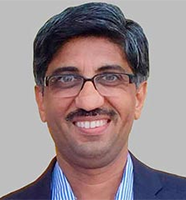Interview with Prof. Abhay Karandikar, Director, Indian Institute of Technology (IIT) Kanpur

 Professor Abhay Karandikar, currently the Director of Indian Institute of Technology (IIT) Kanpur, one of the premier technical institutes of India, is an accomplished educator, innovator, and administrator. Prof Karandikar was also a Member (Part-Time) of the Telecom Regulatory Authority of India (TRAI). Before joining IIT Kanpur as the Director in April 2018, he served as Institute Chair Professor in the Department of Electrical Engineering at Indian Institute of Technology (IIT) Bombay. He also served as Dean (Faculty Affairs) and Head of the Electrical Engineering Department at IIT Bombay. He spearheaded a national effort in setting up the Telecom Standards Development Society of India (TSDSI), India's standards body for telecom, with the participation of all stakeholders. Prof Karandikar was the founding member and former Chairman of TSDSI.
Professor Abhay Karandikar, currently the Director of Indian Institute of Technology (IIT) Kanpur, one of the premier technical institutes of India, is an accomplished educator, innovator, and administrator. Prof Karandikar was also a Member (Part-Time) of the Telecom Regulatory Authority of India (TRAI). Before joining IIT Kanpur as the Director in April 2018, he served as Institute Chair Professor in the Department of Electrical Engineering at Indian Institute of Technology (IIT) Bombay. He also served as Dean (Faculty Affairs) and Head of the Electrical Engineering Department at IIT Bombay. He spearheaded a national effort in setting up the Telecom Standards Development Society of India (TSDSI), India's standards body for telecom, with the participation of all stakeholders. Prof Karandikar was the founding member and former Chairman of TSDSI.
He serves on the board of several companies and has founded and mentored start-ups in telecom and networking. He was a member of the High-Level Forum on 5G set up by the Government of India and Chaired the 5G Spectrum Policy, Task Force. Prof Karandikar has several patents issued and pending, contributions to IEEE, 3GPP standards, contributed chapters in books, and many papers in international journals and conferences to his credit. Prof Karandikar was awarded IEEE SA's Standards Medallion in December 2016 in New Jersey. His team also won the Mozilla Open Innovation challenge prize in March 2017 for his work on rural broadband and contributions to digital empowerment in rural India.
Q1.) Please share your current research work.
AK: My current research work is in the areas of Software Defined Networking (SDN), Network Function Virtualisation (NFV), Rural Broadband Connectivity, and Digital Empowerment.
In the last couple of years, we have been exploring the use of SDN & NFV in cellular mobile communication, specifically for networks beyond 5G. We have developed novel SDN-based architectures for multi-RAT networks and also put forward a number of resource allocation algorithms within the SDN framework.
Another area, where we have made notable contributions recently, is Rural Broadband Connectivity and Digital Empowerment. As you might know, there are significant challenges in providing broadband connectivity in rural areas using existing cellular wireless systems. We have tried to address many of these challenges through our research work.
Our research in these domains have led to the formation of two working groups under IEEE ComSoc Standards Board for the development of technical standards, P1930.1 and P2061. While IEEE P1930 is nearing completion, IEEE P2061 is currently under active development.
Q2.) Please share your most impactful work(s) with us.
AK: Our most impactful work has been in telecom standardizations. Even though we have witnessed spectacular growth in cellular connectivity in the last three decades, broadband penetration, especially in rural India and in many other rural parts of the world, is still limited. There are significant challenges in providing broadband connectivity in rural areas using existing cellular wireless systems. Our group has tried to address some of these challenges through multiple innovations in rural broadband communications technology and digital empowerment. As I mentioned earlier, our group is leading a global standard on rural broadband connectivity, ‘IEEE P2061’ through the working group ‘Frugal 5G Networks’.
Additionally, we also developed the technology of TV UHF band radios and established TV White Space test bed in seven villages in the Palghar district in Maharashtra, India through our research program – ‘Gram Marg’. We also set up a rural broadband pilot with WiFi hotspots in twenty-five villages covering an area of a hundred square kilometers in the same district, demonstrating several frugal innovations. In the past, TV white space trials have been undertaken in US, UK, Japan and Singapore. However, our group was the first one to set up a large-scale test bed in India and undertake the feasibility study of TV white space for broadband connectivity in India.
Motivated by the success of our rural broadband test bed, we pioneered a novel wireless network architecture called “Frugal 5G” for affordable broadband access. The Frugal 5G architecture comprises of a heterogeneous access network wherein large macro cells provide carpet coverage, while wireless local area networks (WLANs) provide additional capacity to serve village clusters with high-speed data. The WLAN is backhauled via a wireless backhaul network also called the middle mile network. This has led to the formation of a working group ‘Frugal 5G Networks’ under IEEE ComSoc Standards board.
The other impactful work from our group is in the area of SDN. We have made significant contributions in the unification of control and management of multiple radio access (multi-RAT) networks such as LTE-4G, 5G-New Radio, WiFi, and TV Broadcast within the framework SDN. Our innovations in this domain led to the formation of the Working Group ‘SDN based Middleware for Control and Management of Networks’ and a standard project “P1930.1-Recommended Practice for Software Defined Networking (SDN) based Middleware for Control and Management of Wireless Networks” again under IEEE ComSoc Standards board.
Our research in SDN and Rural broadband Communication (Frugal 5G) has resulted in a large number of patents as well as research papers. Most importantly, these have led to the development of global technical standards.
Q3.) During these COVID times, the teaching and learning has become online for some time as of now. What do you think are some of the challenges being faced in carrying out quality research? Do you have any suggestions for researchers?
AK: Research scholars are the backbone of research program of the institute, and obviously, their physical absence from research laboratories posed a lot of challenges. Particularly, where the research work involved experimental activities requiring lab work, the challenges were significant. For example, in case of our research group, the 5G test bed & hardware development, on which we were working, got stalled due to the absence of research scholars and project staff. Whereas, those research students, who were working on theoretical aspects, could continue to do some work because they could interact online. For students working on experimental research or the work that required laboratory, access has been affected in a significant way. Therefore, we have started bringing back the PhD students to campus. We started this exercise in September. The idea was that the students who need to be there on campus for their research work, can come back to campus and resume their research activities. I would say that these have been one of the trying times. So, there will be a lot of challenges. However, we should not be distressed and keep our morale high so that we can overcome these challenges.
Q4.) In your opinion, what are some of the most exciting areas of research for students and upcoming researchers?
AK: A lot of exciting research is happening in the communications and signal processing domain, particularly in the area of wireless communications right now. Spectrum and energy efficiency improvements have always been thrust areas for wireless communications and signal processing research. There is a renewed focus on these fundamental questions today due to new advancements such as AI and Machine Learning. We are witnessing increased usage of AI and ML algorithms in resource allocation in access network and in control & management of core network.
With the 5G and beyond technologies touching all sectors of the economy and all spheres of human life, be it healthcare, agriculture, manufacturing, education, entertainment, or transportation, many new use cases are expected to come up in decades to come where the technology is not only going to be used for ‘human to human’ or ‘human to machine’ communications but also for ‘machine to machine’ communications. These changes would lead to exciting research problems requiring significant interdisciplinary work.
Mobile network was originally designed to support a single application, i.e., voice call for users on the move. However, with an ever-increasing diversity of applications today, it has come a long way. An exciting area of research here, that is related to my own work too, is to come up with a flexible, simple yet scalable architecture for mobile networks, which is capable of supporting immense variety of use cases efficiently.
Q5.) As the Director of one of the most elite technical Universities of India, what are your insights on the future of technical education post-COVID era?
In the COVID times, we have shifted entirely to an online mode for teaching and learning. It was quite a learning experience for all of us, not only in terms of using tools for online teaching, but also in terms of assessment and evaluations. Last 6-7 months, we have acquired a lot of expertise or skills in the remote mode of teaching and learning. Though online education cannot be a substitute for in person interaction and mentoring of students, some of these platforms can be put to use for scaling up quality education to a much larger number than what has been possible in our country so far. Given the fact that we have a large population of aspiring youth and only a small percentage of them get access to quality education in some of the best institutes in the country, the online mode of education using technology can be used for imparting high quality technical education to large number of students.

